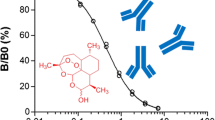Abstract
A high-performance liquid chromatographic (HPLC) assay was developed for pyrimethamine in plasma, red blood cells (RBCs), and buffer for the purpose of studying its plasma protein binding and RBC partitioning. Pyrimethamine (1000 ng/ml) was 94% bound to plasma proteins on average, depending on the pH of plasma. A comparison of the lower and upper range of plasma concentrations that would be achieved after a malaria prophylaxis dosing regimen (25 mg/week) showed that the fraction unbound was significantly lower at 120 ng/ml than at the upper plasma concentration of 360 ng/ml, 3.5 vs 4.9%, respectively. Nonlinear regression of the effect of albumin concentration (g/L) on plasma binding yielded the equation: fraction unbound = 1/[(0.421 * albumin concentration) + 1] (R 2 = 0.99). There was no binding to normal levels of alpha1-acid glycoprotein (AAG). The mean ratio of the concentration of pyrimethamine in RBCs to that in plasma (RBC:plasma ratio) was 0.42, while the mean RBC:buffer ratio was 5.2. Binding to hemolysate did not account for all of the RBC uptake, suggesting that binding to or partitioning into RBC membranes may be important. Because pyrimethamine binding depends on both albumin concentration and pyrimethamine concentration in the plasma, these studies predict greater free fractions of pyrimethamine associated with the higher doses given for toxoplasmosis (75 mg/day) and with the hypoalbuminemia associated with AIDS and malaria.
Similar content being viewed by others
REFERENCES
E. A. Falco, L. G. Goodwin, G. H. Hitchings, I. M. Rollo, and P. B. Russell. Br. J. Pharmacol. 6:185–200 (1951).
L. M. Weiss, C. Harris, M. Berger, H. B. Tanowitz, and M. Wittner. J. Infect. Dis. 157:580–583 (1988).
C. Leport, F. Raffi, S. Matheron, C. Katlama, B. Regnier, A. G. Saimot, C. Marche, C. Vedrenne, and J. L. Vilde. Am. J. Med. 84:94–100 (1988).
D. J. Wyler. In G. L. Mandell, R. G. Douglas, and J. E. Bennett (eds.), Principles and Practice of Infectious Diseases, 2nd ed.), John Wiley and Sons, New York, 1985, pp. 1514–1522.
D. M. Israelski and J. S. Remington. Infect. Dis. Clin. No. Am. 2:429–445 (1988).
J. Klein. Immunology—The Science of Self-Nonself Discrimination, John Wiley and Sons, New York, 1982
R. A. Ahmed and H. J. Rogers. Br J. Clin. Pharmacol. 11:101–102 (1981).
J. C. Cavallito, C. A. Nichol, W. D. Brenckman, R. L. DeAngelis, D. R. Stickney, W. S. Simmons, and C. W. Sigel. Drug Metab. Disp. 6:329–337 (1989).
A. C. Rudy and W. J. Poynor. Pharm. Res. 4:S-9 (1987).
A. C. Rudy. Doctoral dissertation, Virginia Commonwealth University, Richmond, 1987.
K. M. Giacomini, F. M. Wong, and T. N. Tozer. Pharm. Res. 1:179–181 (1984).
O. Brørs, G. Sager, D. Sandnes, and S. Jacobsen. Br. J. Clin. Pharmacol. 15:393–397 (1983).
SAS User's Guide: Statistics, Version 5, SAS Institute, Cary, NC, 1985.
I. M. Klotz. Arch. Biochem. 9:109–117 (1946).
B. Honoré and R. Brodersen. Mol. Pharmacol. 25:137–150 (1984).
M. L. Kornguth and C. M. Kunin. J. Infect. Dis. 133:175–184 (1976).
A. Roos and W. F. Boron. Physiol. Rev. 61:296–421 (1981).
M. H. Jacobs. Cold Spring Harbor Symp. Quant. Biol. 8:30–39 (1940).
G. J. Bowmer and W. E. Lindup. Biochim. Biophys. Acta 624:260–270 (1980).
G. A. Dette, H. Knothe, and G. Herrman. Biochem. Pharmacol. 31:1081–1087 (1982).
D. E. Schwartz, E. Weidekamm, I. Mimica, P. Heizmann, and R. Portmann. Chemotherapy 33:1–8 (1987).
S. L. Robbins. In S. L. Robbins and R. S. Cotran (eds.), The Pathologic Basis of Disease, 2nd ed., W. B. Saunders, Philadelphia, 1979, p. 1137.
L. Laine, E. J. Politoske, and P. Gill. Arch. Intern. Med. 147:1174–1175 (1987).
D. P. Kotler, H. P. Gaetz, M. Lange, E. B. Klein, and P. R. Holt. Ann. Intern. Med. 101:421–428 (1984).
Author information
Authors and Affiliations
Rights and permissions
About this article
Cite this article
Rudy, A.C., Poynor, W.J. Binding of Pyrimethamine to Human Plasma Proteins and Erythrocytes. Pharm Res 7, 1055–1060 (1990). https://doi.org/10.1023/A:1015947301890
Issue Date:
DOI: https://doi.org/10.1023/A:1015947301890




